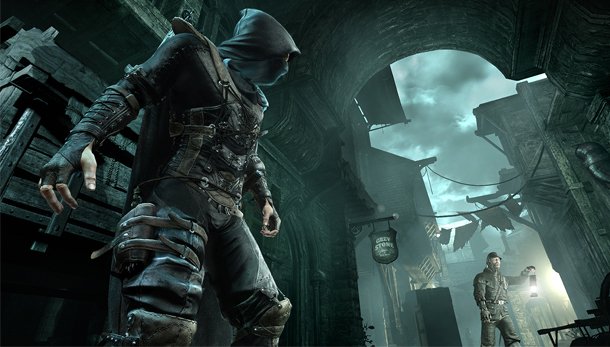Thief hands-on: Eidos Montreal attempt to modernise a stealth classic

“Any Thief fan with any self-respect will be aware of the surface type. But technically, if you just crouch most of the time, you won't have to.” Surface types are used to carve routes through the levels; one path might be grassy and in the light, while another has metallic flooring but is in the dark. “It's a level of mastery on top. If you're careful you can get through it, but you won't win speedruns without it.” That emphasis on mastery is great news for anyone who loved replaying the original Thief games, perfecting each mission.
Twenty minutes later I've passed through basement wine cellars, skipped by arrow traps and crouched on top of a bookcase in a library. Thief 's environments are obviously designed to be snuck through by players like me, but they still feel detailed and real – and even the decadence of this rich man's home is comparatively understated.
I look to a nearby edge, and a prompt appears telling me I can jump across. Jumping is now a context- sensitive action. “Jumping, bouncing up and down, kind of broke the immersion,” says Schmidt. “We didn't want you to be the master thief and you just tend to fall off stuff all the time.” That's fair, but the loss of granular control when you jump feels very un-PC in philosophy. I'll come back to that.
The loss of manoeuvrability is compensated for by the addition of a swoop move, which allows you to duck and dash silently over short distances in a single movement. It's new, but it feels like a fair addition to Garrett's arsenal of abilities. I leap off my bookcase on to the head of a passing guard, knocking him out. Then I grab his leg and drag him into the shadows.

Stolen blueprints suggest the diamond I'm here to steal is being stored inside a hidden room at the building's core. Getting inside the building was hard, but sneaking my way around the stone corridors is straightforward. I extinguish lights with my water arrows, toss bottles to send guards in the wrong direction and crouch-walk my way to an unusual painting. Pressing 'use' on it causes Garrett to lurch forward and press his hands on its surface. I can paw my way across its canvas, on to its frame, and then around until I find a magic switch that causes a secret door to open. The world is full of these touchable objects: traps that can be deactivated with a snipped string; chandeliers that can be dropped with the thunk of a fired arrow; and inside the vault, a puzzle involving spinning cylinders to open a chest.
Ten minutes later and I've rope- arrowed my way out of the house and, after a timeskip to remove a section the developers thought would spoil the story, I'm on a city bridge set on fire by rioters. This is where I end up clambering up a wall face in third- person, and firing a rope arrow in a quick time event to recover from a forced fall.
Daniel explains that the team wanted to “add some small events to break up the pacing and add variety”, but that “in the grand scope of the game they're a very small portion, so you don't have to be worried about it”. I'm not worried, exactly. The Tomb Raider-ish clambering fits with the fantasy of Garrett as a master thief but, much like the contextual jumping, it's philosophically opposed to what makes Thief compelling. Thief is about being alone, powerful, sneaky, and the first three games let you feel that by providing an environment, a set of tools, and allowing you to find your own way through the vast levels.
The biggest gaming news, reviews and hardware deals
Keep up to date with the most important stories and the best deals, as picked by the PC Gamer team.

